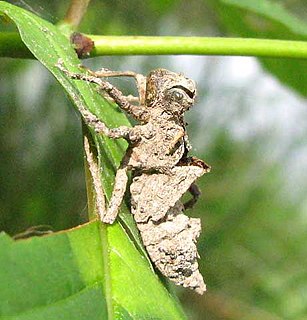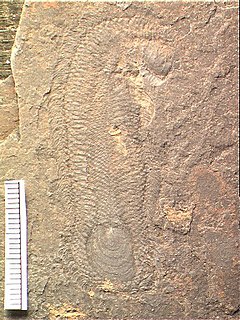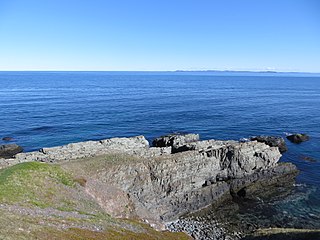
An exoskeleton is the external skeleton that supports and protects an animal's body, in contrast to the internal skeleton (endoskeleton) of, for example, a human. In usage, some of the larger kinds of exoskeletons are known as "shells". Examples of animals with exoskeletons include insects such as grasshoppers and cockroaches, and crustaceans such as crabs and lobsters, as well as the shells of certain sponges and the various groups of shelled molluscs, including those of snails, clams, tusk shells, chitons and nautilus. Some animals, such as the tortoise and turtle, have both an endoskeleton and an exoskeleton.

The halkieriids are a group of fossil organisms from the Lower to Middle Cambrian. Their eponymous genus is Halkieria, which has been found on almost every continent in Lower to Mid Cambrian deposits, forming a large component of the small shelly fossil assemblages. The best known species is Halkieria evangelista, from the North Greenland Sirius Passet Lagerstätte, in which complete specimens were collected on an expedition in 1989. The fossils were described by Simon Conway Morris and John Peel in a short paper in 1990 in the journal Nature. Later a more thorough description was undertaken in 1995 in the journal Philosophical Transactions of the Royal Society of London and wider evolutionary implications were posed.

Shelly limestone is a highly fossiliferous limestone, composed of a number of fossilized organisms such as brachiopods, bryozoans, crinoids, sponges, corals and mollusks. It varies in color, texture and hardness. Coquina is a poorly indurated form of shelly limestone.

Helcionellid or Helcionelliformes is an order of small fossil shells that are universally interpreted as molluscs, though no sources spell out why this taxonomic interpretation is preferred. These animals are first found about 540 to 530 million years ago in the late Nemakit-Daldynian age, which is the earliest part of the Cambrian period. A single species persisted to the Early Ordovician. These fossils are component of the small shelly fossils (SSF) assemblages.
The small shelly fauna, small shelly fossils (SSF), or early skeletal fossils (ESF) are mineralized fossils, many only a few millimetres long, with a nearly continuous record from the latest stages of the Ediacaran to the end of the Early Cambrian Period. They are very diverse, and there is no formal definition of "small shelly fauna" or "small shelly fossils". Almost all are from earlier rocks than more familiar fossils such as trilobites. Since most SSFs were preserved by being covered quickly with phosphate and this method of preservation is mainly limited to the Late Ediacaran and Early Cambrian periods, the animals that made them may actually have arisen earlier and persisted after this time span.
Anabarites is a problematic lower Cambrian genus, and is one of the small shelly fossils. It was abundant in the early Tommotian and is also found in the Nemakit-Daldynian. The fossils represent the triradially symmetrical mineralised tube in which the organism dwelt; it was sedentary. It is named after the Anabar region in Yakutia, Russia; its name does not imply 'heavy'.

The Stratigraphy of the Cambrian period currently has several schemes used for ordering geologic formations from the period. The International Commission on Stratigraphy−ICS scheme has set a stratotype section for the base of the Cambrian, dated quite accurately to 541 ± 1.0 million years ago. Russian and Chinese scientists have developed a different scheme.
The Phyllopod bed, designated by USNM locality number 35k, is the most famous fossil-bearing member of the Burgess shale fossil Lagerstätte. It was quarried by Charles Walcott from 1911–1917, and was the source of 95% of the fossils he collected during this time; tens of thousands of soft-bodied fossils representing over 150 genera have been recovered from the Phyllopod bed alone.
Eiffelia is an extinct genus of sponges known from the Middle Cambrian Burgess Shale as well as several Early Cambrian small shelly fossil deposits. It is named after Eiffel Peak, which was itself named after the Eiffel Tower. It was first described in 1920 by Charles Doolittle Walcott. It belongs in the Hexactinellid stem group. 60 specimens of Eiffelia are known from the Greater Phyllopod bed, where they comprise 0.11% of the community.

Fordilla is an extinct genus of early bivalves, one of two genera in the extinct family Fordillidae. The genus is known solely from Early Cambrian fossils found in North America, Greenland, Europe, the Middle East, and Asia. The genus currently contains three described species, Fordilla germanica, Fordilla sibirica, and the type species Fordilla troyensis.
Mackinnonia is a genus of small shelly fossil comprising straight or slightly coiled shells of the helcionelloid type. The outer surface of their shell is smooth, whereas the inner surface has a net-like ridges. They are known from late Early Cambrian rocks across North America and Greenland.

Allonnia is a genus of coeloscleritophoran known as complete scleritomes from the Middle Cambrian Burgess Shale. It is also a constituent of the small shelly fauna.
Mongolitubulus is a form genus encapsulating a range of ornamented conical small shelly fossils of the Cambrian period. It is potentially synonymous with Rushtonites, Tubuterium and certain species of Rhombocorniculum, and owing to the similarity of the genera, they are all dealt with herein. Organisms that bore Mongolitubulus-like projections include trilobites, bradoriid arthropods and hallucigeniid lobopodians.
A megabias, or a taphonomic megabias is a large scale pattern in the quality of the fossil record that affects paleobiologic analysis at provincial to global levels and at timescales usually exceeding ten million years. It can result from major shifts in intrinsic and extrinsic properties of organisms, including morphology and behaviour in relation to other organisms, or shifts in the global environment, which can cause secular or long-term cyclic changes in preservation.
Pojetaia is an extinct genus of early bivalves, one of two genera in the extinct family Fordillidae. The genus is known solely from Early to Middle Cambrian fossils found in North America, Greenland, Europe, North Africa, Asia, and Australia. The genus currently contains two accepted species, Pojetaia runnegari, the type species, and Pojetaia sarhroensis, though up to seven species have been proposed. The genera Buluniella, Jellia, and Oryzoconcha are all considered synonyms of Pojetaia.

Small carbonaceous fossils (SCFs) are sub-millimetric organic remains of organisms preserved in sedimentary strata.

The Yanjiahe Formation is a Cambrian fossiliferous geologic formation found in South China.
Protohertzina is a genus of conodonts or, possibly, Chaetognaths, found at the beginning of the Cambrian explosion.
Rafatazmia chitrakootensis the sole member of the genus Rafatazmia is a fossil species of filamentous alga described from dolomite obtained from the Vindhya ranges of central India. It is among the oldest known eukaryotic life forms and dates to about 1600 million years. The genus is named after Rafat Azmi, the Indian paleontologist who discovered other fossils in the same area and whose findings were doubted.







